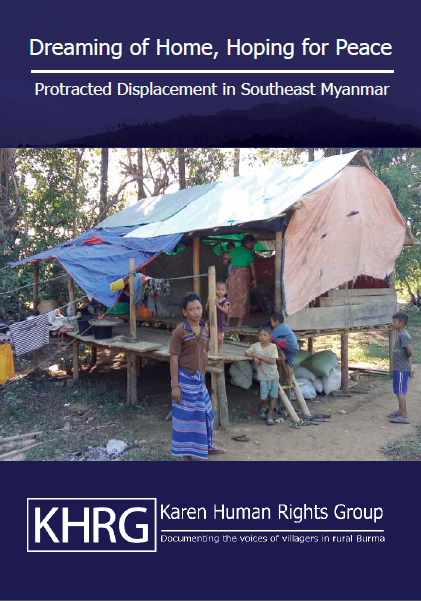Dreaming of Home, Hoping for Peace: Protracted Displacement in Southeast Myanmar
22 May 2019


Executive Summary
War, violence and persecution have uprooted record numbers of men, women and children worldwide. At the start of 2018, an unprecedented 68.5 million people around the world were displaced from their homes. In Myanmar, decades of ethnic conflict, political repression and systematic human rights violations have led hundreds of thousands of people to flee their homes to makeshift hideaways in the jungle, more established IDP sites, or refugee camps in neighbouring countries.
According to the Guiding Principles on Internal Displacement, internally displaced persons (IDPs) are “persons or groups of persons who have been forced or obliged to flee or to leave their homes or places of habitual residence, in particular as a result of or in order to avoid the effects of armed conflict, situations of generalised violence, violations of human rights or natural or human-made disasters, and who have not crossed an internationally recognised border.” The Internal Displacement Monitoring Centre (IDMC) estimates that 635,000 people are displaced due to conflict and violence in Myanmar. However, accurate data is hard to obtain for Myanmar. Because of long-standing conflict, many communities live in a state of protracted, cyclical displacement, leaving their homes and fleeing into the jungle when fighting occurs, but periodically returning to their villages to harvest their crops or find food.
In Southeast Myanmar, despite the 2015 Nationwide Ceasefire Agreement (NCA), ethnic communities continue to face the effects of violent conflict, heavy militarisation, and extensive landmine contamination. Large-scale infrastructure projects, such as the Asian Highway and the Hatgyi Dam, have also contributed to rising tensions and violence between armed actors. An increase in land confiscations has devastated rural communities, resulting in displacement and a loss of livelihoods.
To highlight the impacts of protracted displacement in Southeast Myanmar, the Karen Human Rights Group has chosen to analyse the situation in Myaing Gyi Ngu in this report. This IDP site is home to 5,610 people who have been displaced for over two years. Unable to return home because of militarisation and landmines, hundreds of families struggle to make ends meet. A decline in humanitarian assistance is concerning, especially since IDPs do not have opportunities to work to support themselves or their families. Many of them have put themselves in great danger, crossing into landmine-contaminated areas to scavenge for food or work on their plantations. The IDPs interviewed for this report articulated an overwhelming desire to return to their villages and live in peace. Continuing tensions between armed actors and the push to construct the Hatgyi Dam threaten to impede their return and cause further displacement.
Through this report, KHRG hopes to amplify the concerns of IDPs, whose voices should be taken into account by the Myanmar government, the Karen National Union (KNU), and humanitarian aid providers. The needs and perspectives of conflict-affected populations must be addressed in Myanmar’s ongoing peace process. Increased humanitarian assistance is necessary to meet the needs of the most vulnerable communities in Myanmar, where the government has failed to provide protection and support.
Download full report in English here.
Download full report in Burmese here.
၎
င
၎
၎
Announcements
28 February 2025
Asian NGO Network on National Human Rights Institutions , CSO Working Group on Independent National Human Rights Institution (Burma/Myanmar)
Open letter: Removal of the membership of the dis-accredited Myanmar National Human Rights Commission from the Southeast Asia National Human Rights Institution Forum

Progressive Voice is a participatory rights-based policy research and advocacy organization rooted in civil society, that maintains strong networks and relationships with grassroots organizations and community-based organizations throughout Myanmar. It acts as a bridge to the international community and international policymakers by amplifying voices from the ground, and advocating for a rights-based policy narrative.